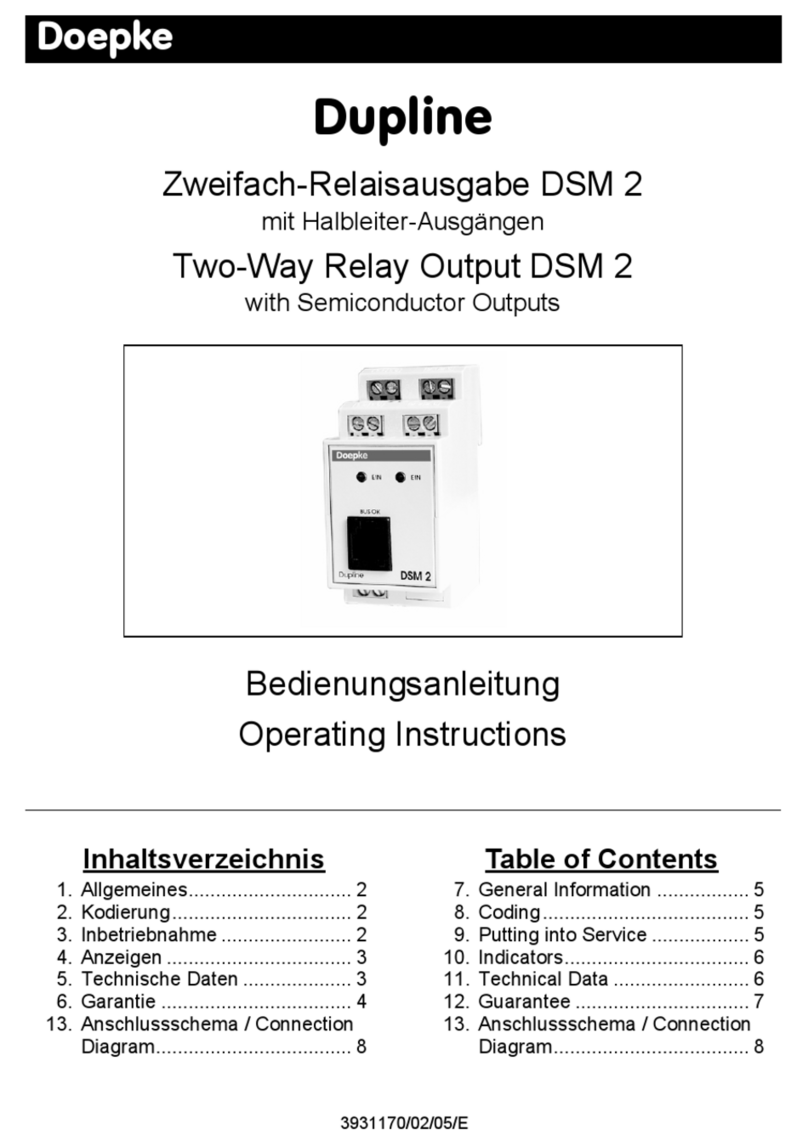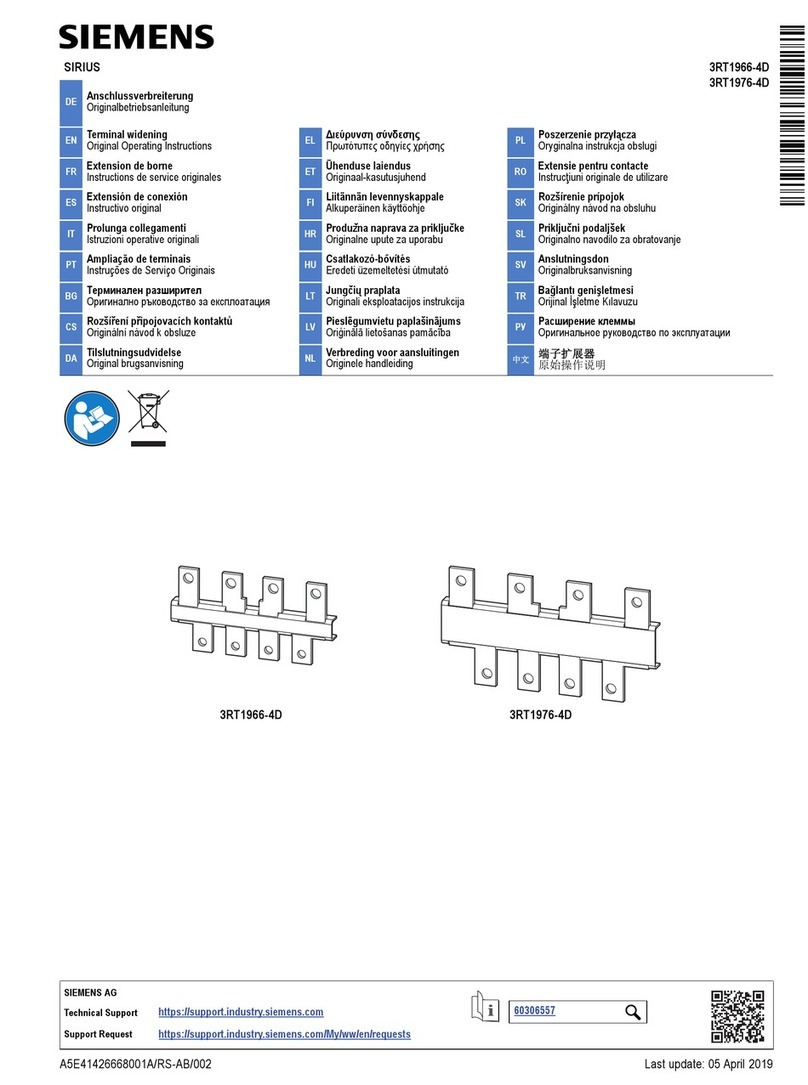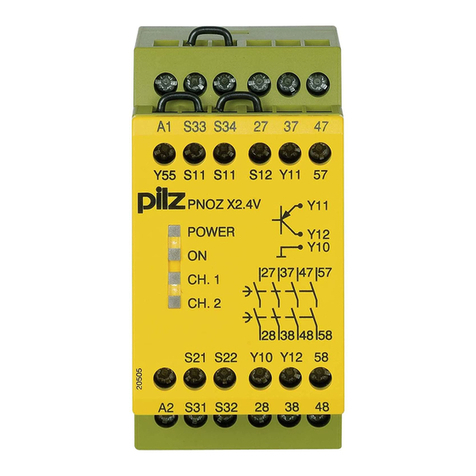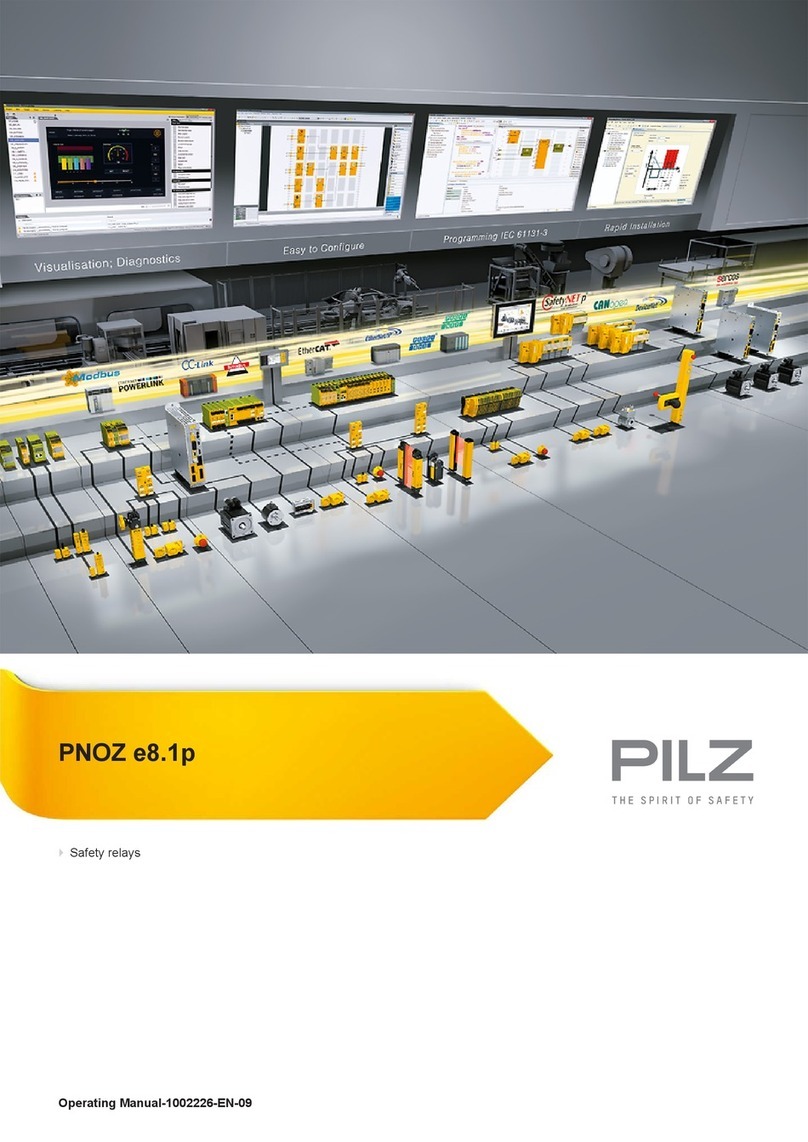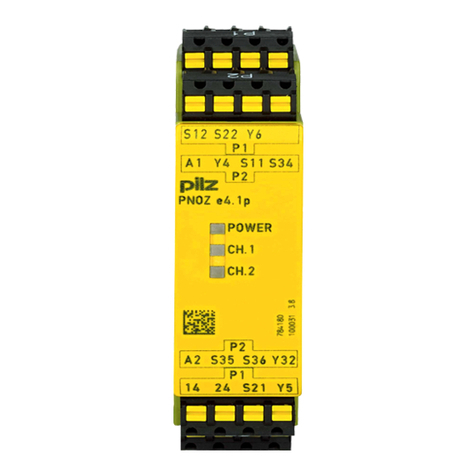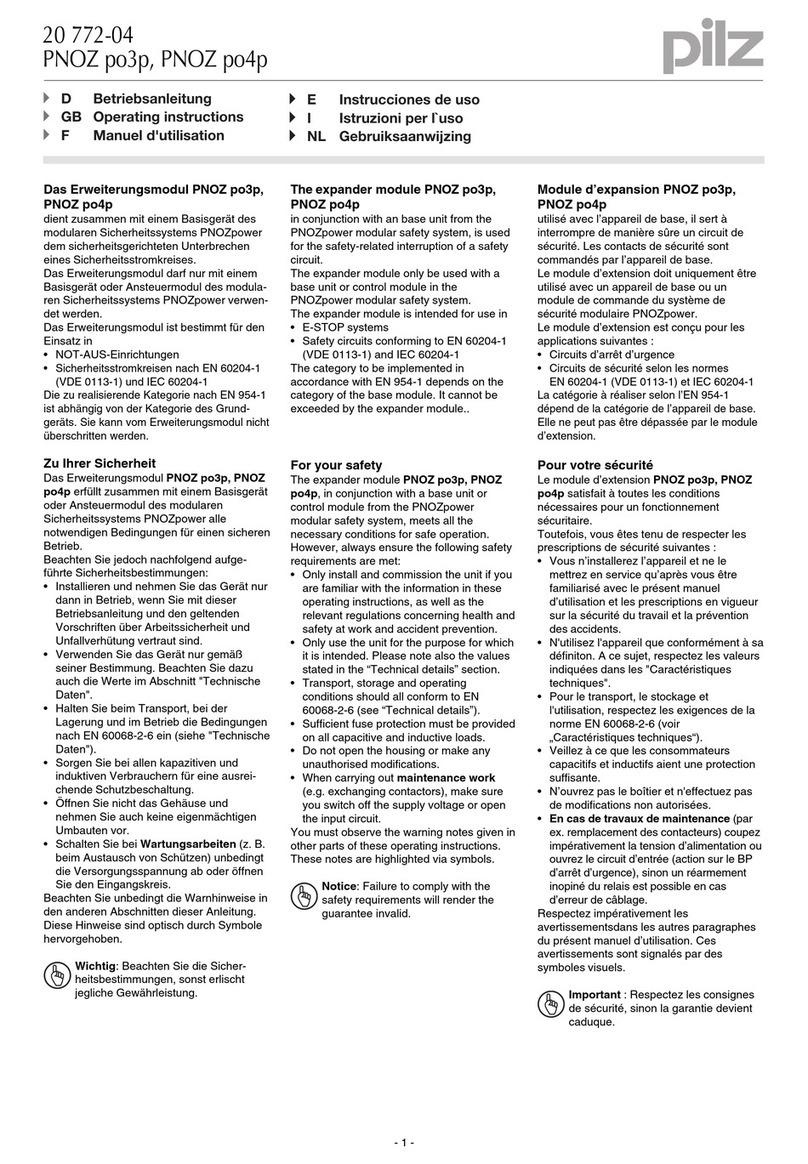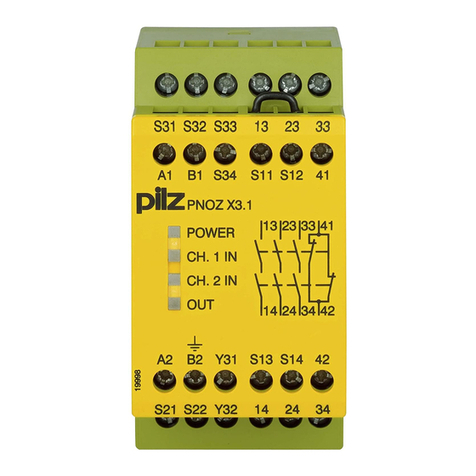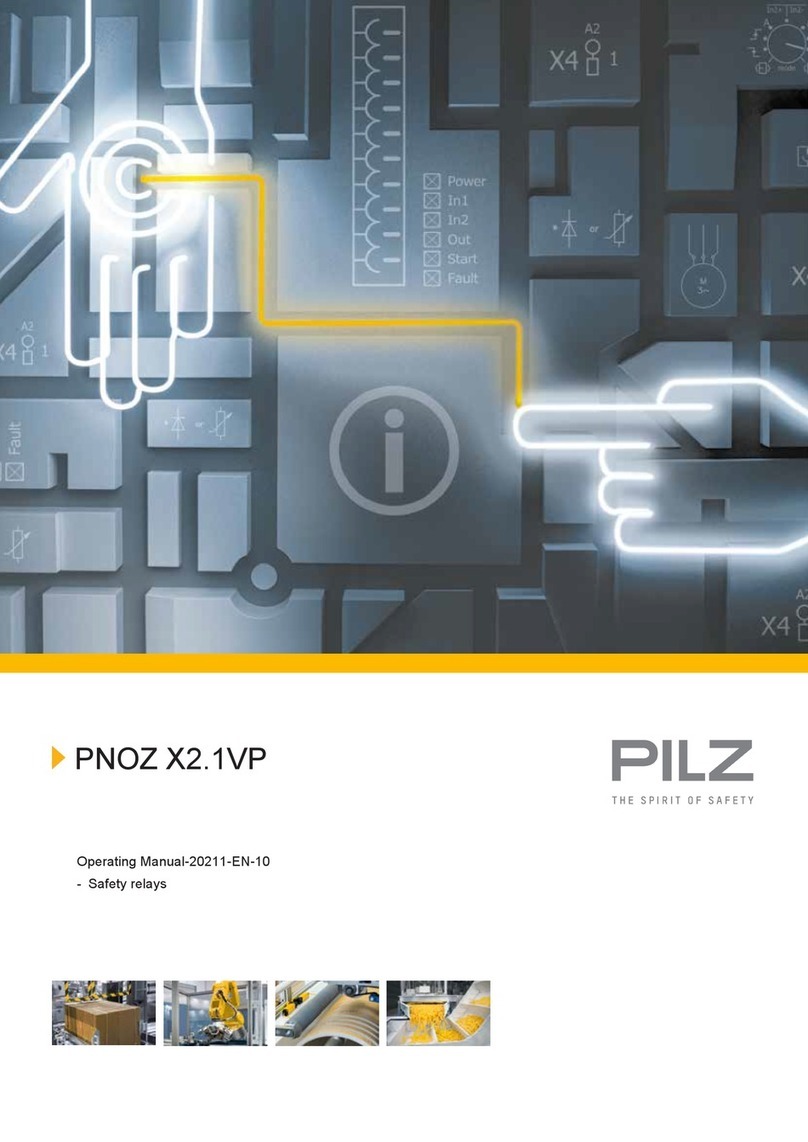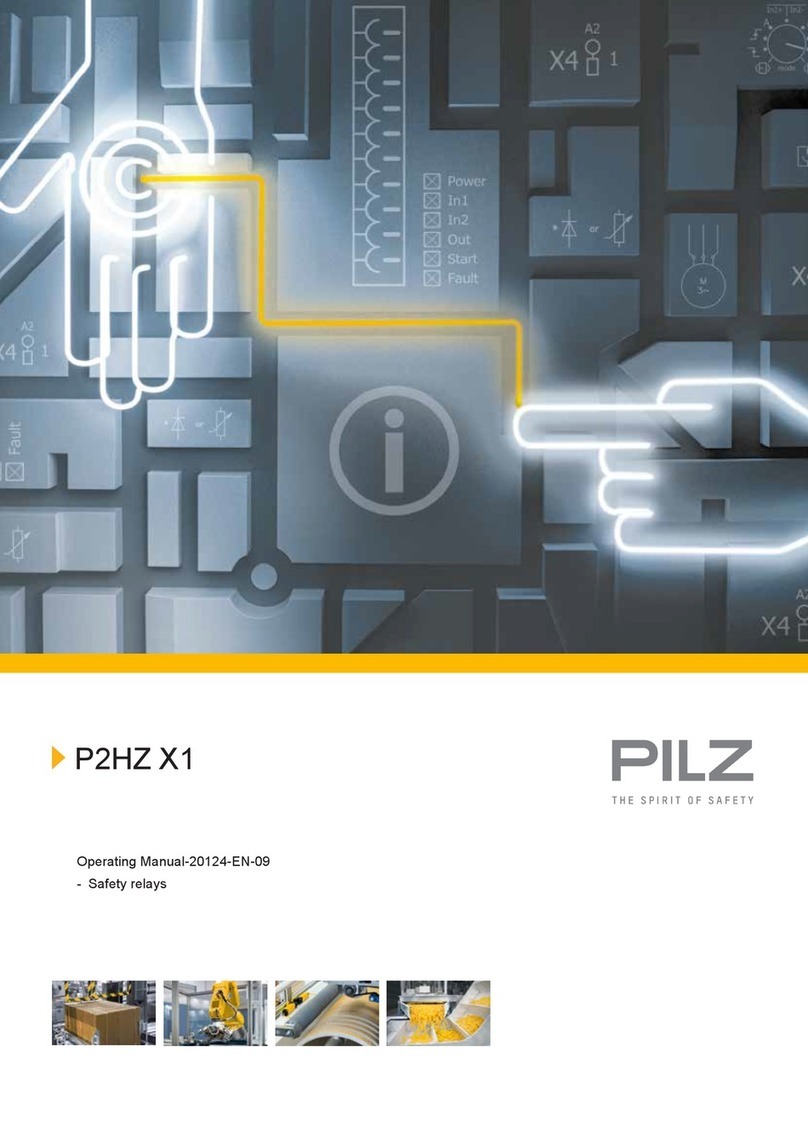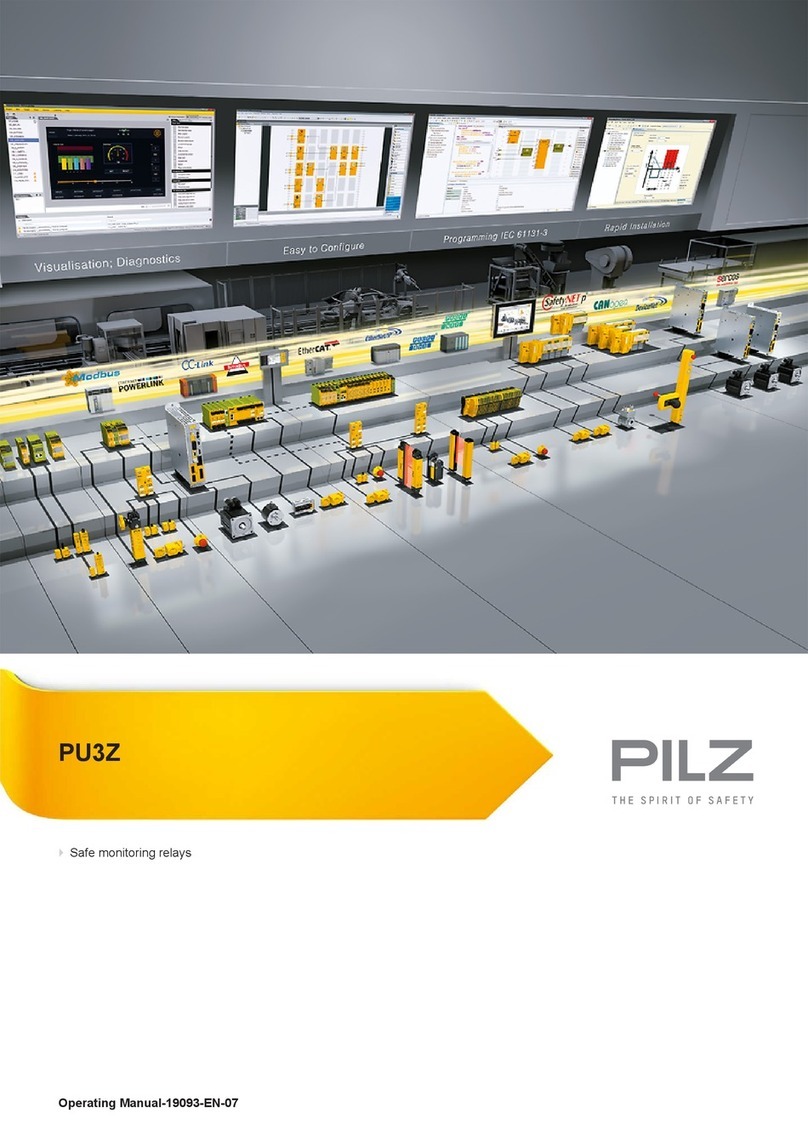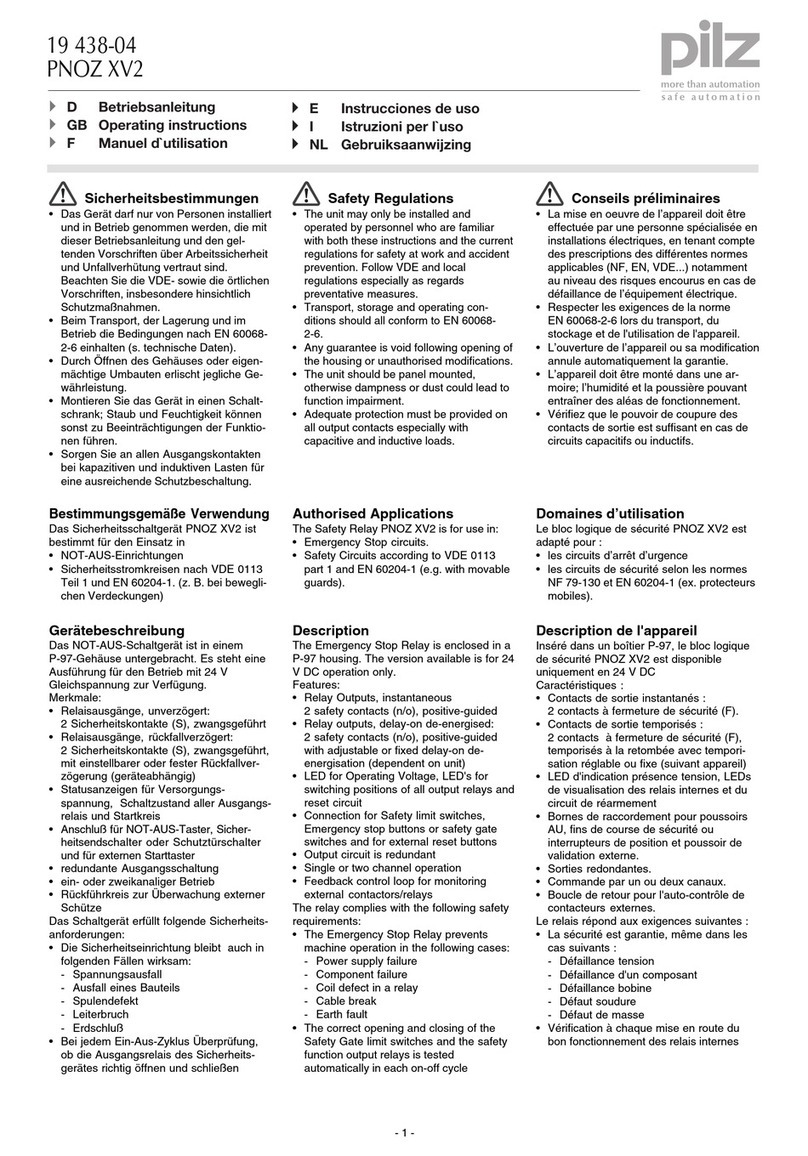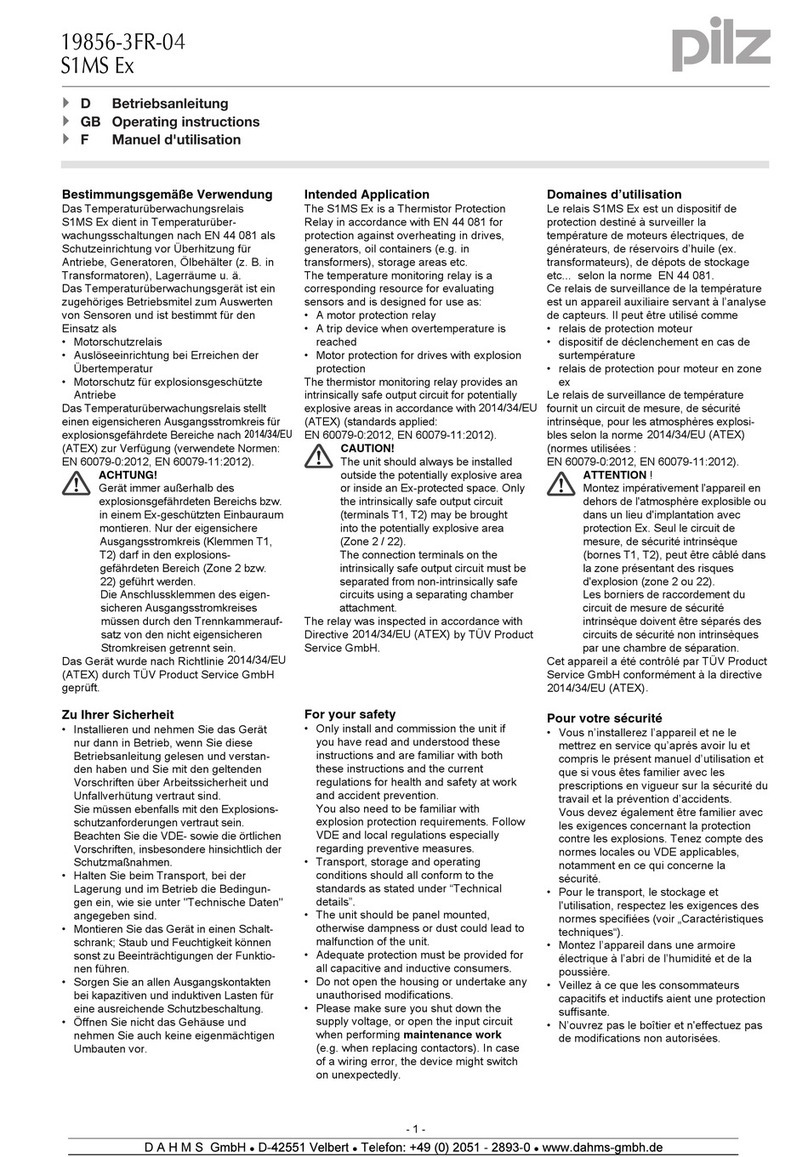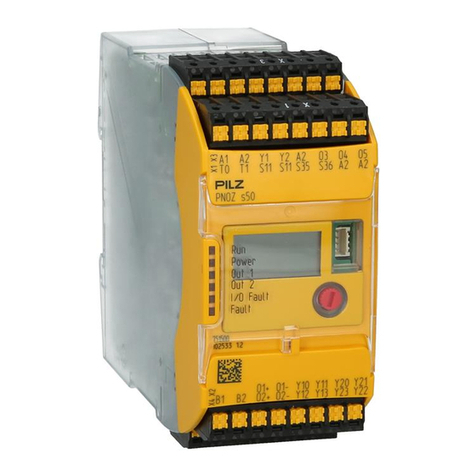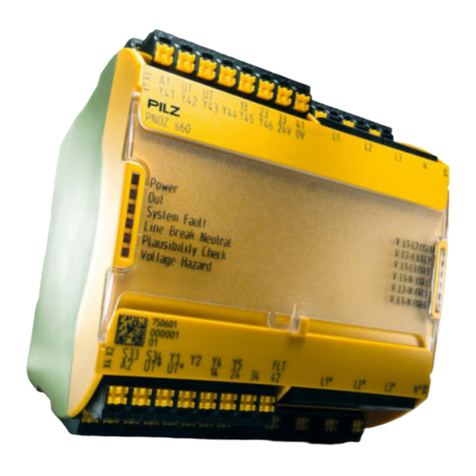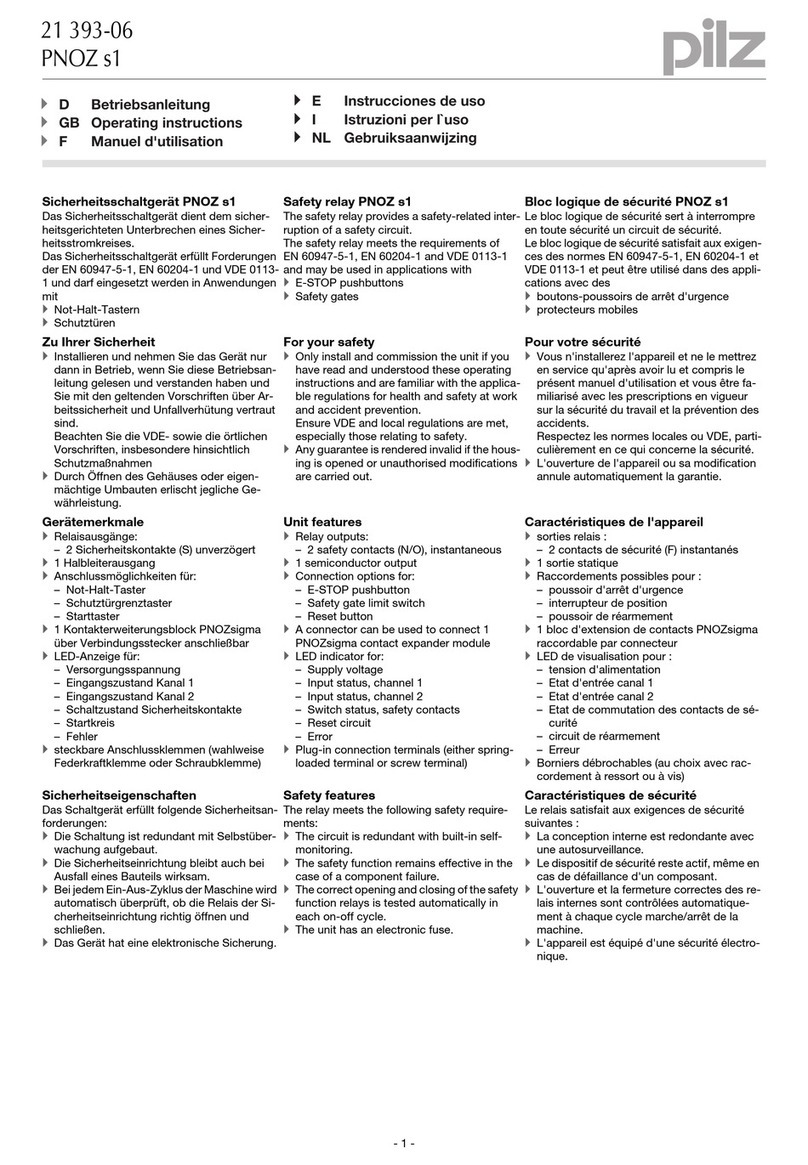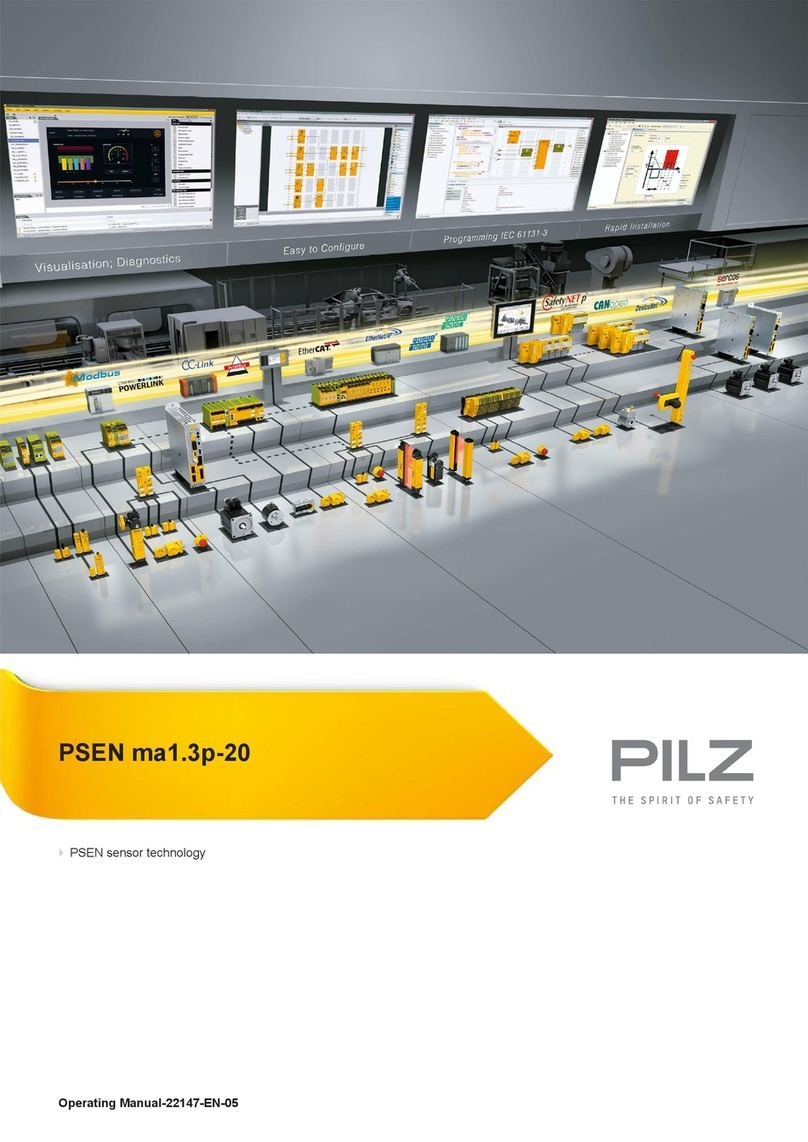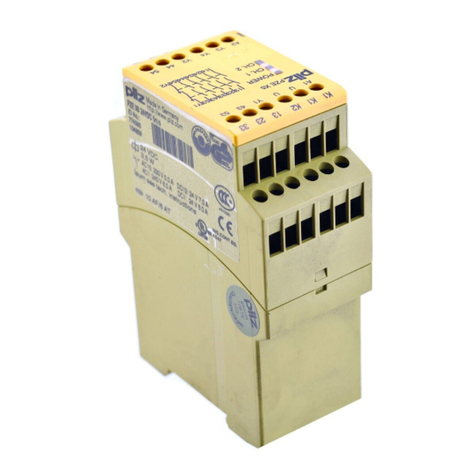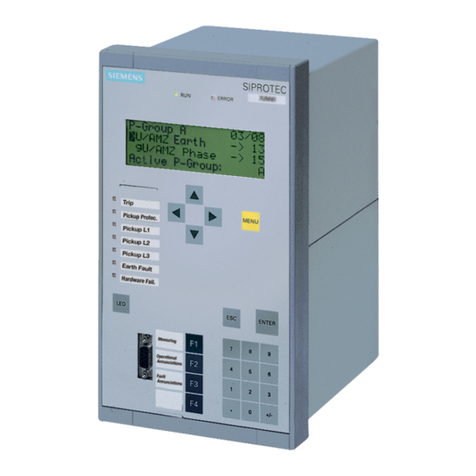
- 4 -
Zweihandbediengerät montieren
Achtung! Durch elektrostatische
Entladung können Bauteile des
Sicherheitssystems beschädigt
werden. Sorgen Sie für Entladung,
bevor Sie das Sicherheitssystem
berühren, z. B. durch Berühren
einer geerdeten, leitfähigen Fläche
oder durch Tragen eines geerdeten
Armbands.
• Montieren Sie das Zweihandbediengerät
in einen Schaltschrank mit einer Schutz-
art von mindestens IP54.
• Befestigen Sie das Gerät mit Hilfe des
Rastelements auf der Rückseite auf einer
Normschiene.
• Sichern Sie das Gerät bei Montage auf
einer senkrechten Tragschiene (35 mm)
durch ein Halteelement (z. B. Endhalter
oder Endwinkel)
Achtung!
UND-/ODER- Verknüpfung:
• Montieren Sie alle über die UND-/
ODER- Eingänge verknüpften
Geräte im gleichen Schaltschrank
oder
• Stellen Sie sicher, dass Fehler
über die Verbindung der Geräte
ausgeschlossen werden z.B.
durch geschützte Verlegung der
Verbindungsleitung.
Der Abstand der Taster des
Zweihandbediengeräts von der
nächstgelegenen Gefahrenstelle
muss so groß sein, dass beim
Loslassen auch nur eines Tasters die
gefährliche Bewegung unterbrochen
wird, bevor der Bediener die
Gefahrenstelle erreicht bzw. bevor der
Bediener in die Gefahrenstelle
hineingreifen kann (s. EN 999 "Hand-
Arm-Geschwindigkeit").
Zweihandbediengerät in Betrieb
nehmen
Inbetriebnahme vorbereiten
Beachten Sie bei der Vorbereitung der
Inbetriebnahme:
• Das Gerät und die Eingangskreise
müssen immer aus einem Netzteil
versorgt werden.
• Die Betriebsspannung des Zweihandbe-
diengeräts darf nur nach der Ausschalt-
einrichtung gemäß § 9 VBG 7n5.1/2
angeschlossen werden.
• Verwenden Sie Leitungsmaterial aus
Kupferdraht mit einer Temperaturbe-
ständigkeit von 60/75°C.
• Berechnung der max. Leitungslänge Imax
am Eingangs- und Rückführkreis:
R
lmax
R
l
/ km
I
max
=
Rlmax = max. Gesamtleitungs-
widerstand (s. technische Daten)
Rl/km = Leitungswiderstand/km
• Ausgang 14, 24: bei Leerlauf eine
Kapazität bis max. 2 nF ansteuerbar
• Verlegen Sie die Verbindungskabel
zwischen PNOZ e2.2p und den Tastern
nicht unmittelbar neben Starkstromleitun-
gen; es können sonst induktive und
kapazitive Störeinkopplungen entstehen.
Installing the two-hand relay
Caution! Electrostatic discharge
can damage components on the
safety system. Ensure against
discharge before touching the safety
system, e.g. by touching an earthed,
conductive surface or by wearing an
earthed armband.
• The two-hand relay must be installed in a
control cabinet with a minimum protection
type of IP54.
• Use the notch on the rear of the unit to
attach it to a DIN rail.
• If the unit is installed on a vertical
mounting rail (35 mm), ensure it is
secured using a fixing bracket such as
end bracket.
Caution!
AND-/OR connection:
• Install all the devices that are
linked via the AND/OR inputs in
the same control cabinet
or
• make sure that faults that occur
from the connection of the
devices can be excluded, e.g. by
secure laying of connection
cables.
The distance of the button connected
to the two-hand relay from the nearest
danger zone must be large enough
that if one of the buttons is released,
the hazardous movement is
interrupted before the operator can
reach into the danger zone (see
EN 999 "hand-arm speed").
Installer le relais de commande
bimanuelle
Attention ! Une décharge électro-
statique peut endommager les
éléments du système de sécurité.
Veillez à vous décharger avant de
toucher le système de sécurité, par
ex. en touchant une surface
conductrice mise à la terre ou en
portant un bracelet de mise à la
terre.
• Installez le relais de commande
bimanuelle dans une armoire d’indice de
protection IP54 au moins.
• Montez l’appareil sur un rail normalisé à
l’aide du système de fixation situé au dos
du relais.
• Immobilisez l'appareil monté sur un rail
DIN vertical (35 mm) à l'aide d'un élément
de maintien comme par ex. un support ou
une équerre terminale.
Attention ! Liaison ET/OU :
• Montez l'ensemble des appareils
reliés via les entrées ET/OU dans
la même armoire électrique
ou
• assurez-vous que la connexion
des appareils n'entraîne pas
d'erreurs, en protégeant, par
exemple, les câbles de
raccordement entre les appareils.
La distance entre les boutons
poussoirs de la commande
bimanuelle et la zone dangereuse la
plus proche doit être telle qu’un
opérateur lâchant un des boutons
poussoirs ne puisse atteindre la zone
dangereuse avant l’arrêt des
éléments mobiles dangereux, compte
tenu de la vitesse d’approche définie
dans la norme EN 999.
Mettre en service lerelais de
commande bimanuelle
Préparation de la mise en service
Pour préparer la mise en service, respectez
les consignes suivantes :
• L’appareil et les circuits d’entrée doivent
toujours être reliés à la même source
d’alimentation.
• Le branchement de la tension
d’alimentation du relais de commande
bimanuelle peut uniquement s’effectuer
via un dispositif de coupure conformé-
ment aux prescriptions § 9 VBG 7n5.1/2.
•
Utilisez des fils de câblage en cuivre
supportant des températures de 60/75 °C.
• Calcul de la longueur de conducteur Imax
sur le circuit d’entrée et boucle de retour :
R
lmax
R
l
/ km
I
max
=
Rlmax = résistance de câblage totale
max. (voir les caractéristiques
techniques)
Rl/km = résistance du câble/km
• Sorties 14, 24 : en cas de fonctionnement
à vide, une capacité max. de 2 nF peut
être contrôlée.
• Pour éviter des interférences inductives
ou capacitives, il est préférable de placer
le câble reliant le PNOZ e2.2p aux
boutons de commande à l’écart des
câbles de puissance.
Commissioning the two-hand relay
Preparing for commissioning
Please note the following when preparing
for commissioning:
• Power for the unit and the input circuits
must always be provided from a single
power supply.
• The operating voltage for the two-hand
relay may only be connected according to
§ 9 VBG 7n5.1/2 (cut-out devices).
• Use copper wire that will withstand
temperatures of 60/75 °C.
• Calculating the max. cable length Imax at
the input circuit and feedback loop:
R
lmax
R
l
/ km
I
max
=
Rlmax = max. overall cable
resistance (see Technical details)
Rl/km = cable resistance/km
• Output 14, 24: at no-load, a capacitance
of max. 2 nF can be driven
• To avoid inductive and capacitance
coupling, the cables between the
PNOZ e2.2p and the push buttons must
be run separately to any power cables.




